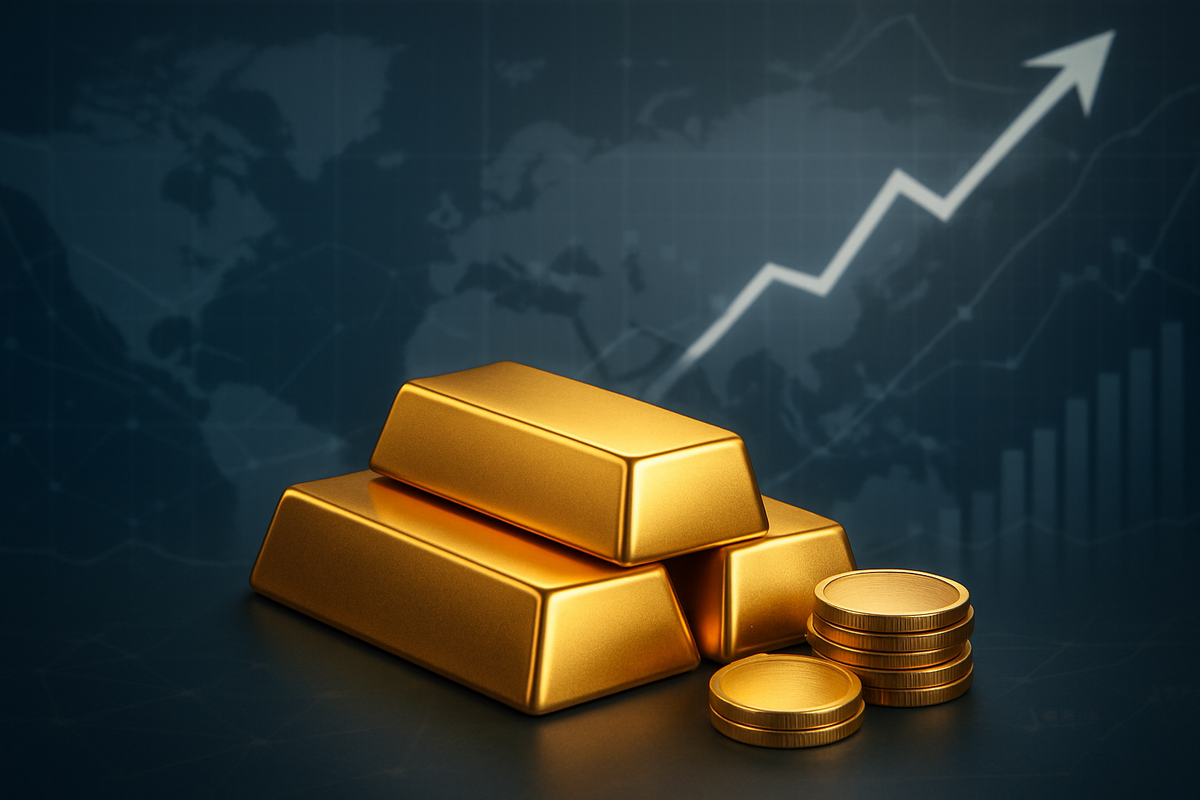
KUALA LUMPUR – Gold futures on Bursa Malaysia Derivatives concluded trading today, October 8, 2025, significantly higher, marking a continuation of a robust upward trend for the precious metal. This surge is largely attributed to persistent safe-haven demand fueled by an increasingly uncertain global economic landscape and strategic buying from central banks worldwide. The gains across various contract months underscore a strong market sentiment, with investors flocking to gold as a hedge against inflation and geopolitical instability.
The immediate implications of this rise are a bolstering of gold's position as a premier safe-haven asset, potentially signaling a prolonged period of elevated prices. For market participants, this trend suggests a cautious outlook on traditional risk assets, with capital flowing into commodities deemed more stable during turbulent times. The sustained demand indicates that underlying global economic anxieties are far from subsiding, prompting a significant reallocation of investment portfolios.
Detailed Market Movements and Contributing Factors
Today's trading session saw a notable ascent across all gold futures contracts on Bursa Malaysia Derivatives. The spot-month October 2025 contract experienced a significant jump, closing at US$4,047.10 per troy ounce, up from yesterday's US$3,974.30. Similarly, the November 2025 contract rose to US$4,065.30 from US$3,992.50, and the December 2025 contract climbed to US$4,079.80 from US$4,007.0. Longer-dated contracts, including January 2026, February 2026, April 2026, and June 2026, also settled higher, all reaching US$4,113.70 per troy ounce, reflecting a broad-based bullish sentiment.
This latest surge is not an isolated event but rather the culmination of a sustained upward trajectory observed over several months. In September 2025, gold futures consistently closed higher, driven by similar global cues. For instance, on September 29, 2025, contracts saw gains, with the September 2025 contract rising to US$3,817.3. Earlier in July 2025, contracts also ended higher, with the spot-month July contract reaching USD3,360.0 per troy ounce on July 19, 2025. This consistent performance highlights gold's enduring appeal amidst fluctuating market conditions.
The primary catalysts behind gold's impressive run are multifaceted. Global economic uncertainty remains a paramount driver, pushing investors towards assets perceived as stable stores of value. This is compounded by a "steady hum" of central bank demand, with major economies like China continuously expanding their gold reserves. Furthermore, renewed expectations of the US Federal Reserve easing its monetary policy, potentially through interest rate cuts, have made non-interest-bearing assets like gold more attractive. A weakening US dollar also plays a crucial role, making gold cheaper for international buyers and thus boosting demand.
Other significant factors include the looming risk of a US government shutdown, which historically prompts a flight to safety, and gold's traditional role as a hedge against inflation. Geopolitical tensions and political instability across various regions further amplify gold's allure. Market anticipation surrounding key US labor data, such as the Nonfarm Payrolls report, can also influence prices, with weaker outcomes potentially leading to a reset of Fed expectations, a weaker dollar, and fresh momentum for gold. The inverse correlation between gold and interest rates also ensures that lower rates decrease the opportunity cost of holding gold, enhancing its appeal.
Corporate Beneficiaries and Potential Losers
The sustained rally in gold prices presents a clear dichotomy for public companies, creating significant winners and potential losers across various sectors. Gold mining companies are undoubtedly among the primary beneficiaries. Companies like Barrick Gold (NYSE: GOLD), Newmont Corporation (NYSE: NEM), and Agnico Eagle Mines (NYSE: AEM) stand to gain substantially from higher gold prices, as their primary product commands a premium. Increased revenue per ounce of gold extracted directly translates to improved profitability, stronger balance sheets, and potentially higher shareholder returns. Exploration and development companies in the gold sector may also find it easier to secure funding for new projects, as the economics of gold extraction become more favorable.
Conversely, industries heavily reliant on gold as a raw material, such as jewelry manufacturers and certain high-tech electronics companies, could face increased input costs. Jewelry retailers like Tiffany & Co. (NYSE: TIF) (part of LVMH Moët Hennessy Louis Vuitton SE (EPA: MC)) or Signet Jewelers (NYSE: SIG) might see their profit margins squeezed if they cannot fully pass on the higher costs to consumers. While luxury brands often have more pricing power, a prolonged surge in gold prices could still impact sales volumes or necessitate strategic adjustments in product offerings. Companies in the financial sector that offer gold-backed products or ETFs, such as SPDR Gold Shares (NYSE Arca: GLD), could see increased investor interest and asset under management, but those with significant short positions on gold futures might incur losses.
Furthermore, general market sentiment driven by gold's rise can affect broader investment portfolios. While gold miners thrive, other sectors, particularly those sensitive to economic uncertainty, might experience headwinds. Companies in cyclical industries, such as automotive or consumer discretionary, could see reduced consumer spending if the underlying global economic anxieties persist and impact household incomes. Financial institutions with significant exposure to these vulnerable sectors through lending or investment could indirectly face challenges, even if they have no direct involvement with gold.
Wider Significance and Market Implications
The current surge in gold futures on Bursa Malaysia Derivatives is more than just a commodity price movement; it is a significant indicator of broader industry trends and global economic sentiment. This event firmly entrenches gold's role as the quintessential safe-haven asset during periods of heightened uncertainty. The sustained demand from both individual investors and central banks highlights a collective move towards de-risking portfolios and diversifying away from traditional fiat currencies and volatile equity markets. This trend aligns with a growing skepticism about global economic stability and the efficacy of conventional monetary policies.
The potential ripple effects of this gold rally are far-reaching. For competitors and partners in the financial markets, the shift towards gold could mean reduced liquidity in other asset classes, impacting trading volumes and investment flows. Central banks' continued accumulation of gold also suggests a strategic pivot away from reliance on the US dollar as the sole global reserve currency, potentially accelerating a move towards a multi-polar financial system. This has significant geopolitical implications, as countries seek to insulate their economies from external shocks and exert greater financial autonomy.
Regulatory and policy implications are also noteworthy. If the US Federal Reserve indeed eases its monetary policy as anticipated, it could set a precedent for other central banks to follow suit, leading to a global environment of lower interest rates. This would further enhance gold's attractiveness by reducing the opportunity cost of holding the non-yielding asset. Historically, periods of significant gold appreciation often coincide with major economic downturns or periods of high inflation, such as the 1970s or the post-2008 financial crisis era. The current environment, characterized by inflation concerns and geopolitical tensions, draws strong parallels to these historical precedents, suggesting that gold's current performance is not an anomaly but a reflection of deeply rooted systemic issues.
The Road Ahead: Short-term and Long-term Outlook
Looking ahead, the short-term trajectory for gold futures appears bullish, contingent on the persistence of global economic uncertainty and the anticipated monetary policy actions of the US Federal Reserve. Should the Fed proceed with interest rate cuts, gold is likely to receive further impetus, potentially pushing prices even higher. Geopolitical events, such as ongoing conflicts or new flashpoints, will also play a critical role, with any escalation typically leading to an immediate surge in safe-haven demand. Investors should closely monitor upcoming US labor data and inflation reports, as these will heavily influence the Fed's decisions and, consequently, gold prices.
In the long term, gold's prospects remain strong, especially if the underlying structural issues driving current demand—such as central bank diversification, persistent inflation concerns, and a potential recalibration of the global financial order—continue to unfold. This sustained demand could lead to strategic pivots across various industries. Gold mining companies may accelerate exploration and production efforts, while financial institutions might develop more sophisticated gold-backed investment products to cater to growing investor interest. Market opportunities may emerge in derivatives markets, offering new avenues for hedging and speculation on gold price movements.
However, challenges also loom. A sudden reversal in global economic sentiment, perhaps driven by unexpected geopolitical resolutions or a surprisingly hawkish shift in central bank policies, could temper gold's rally. A stronger-than-expected economic recovery, particularly in the US, could diminish safe-haven demand and strengthen the dollar, putting downward pressure on gold. Potential scenarios include a continued, gradual ascent in gold prices, punctuated by minor corrections, or a more volatile trajectory influenced by rapidly changing headlines. The most significant outcome to watch for is how long central banks maintain their buying spree and whether inflation truly becomes entrenched, cementing gold's role as a long-term store of value.
Comprehensive Wrap-up and Investor Insights
In summary, the recent surge in gold futures on Bursa Malaysia Derivatives, culminating in today's higher close on October 8, 2025, is a powerful testament to gold's enduring appeal as a safe-haven asset. Key takeaways include the significant impact of global economic uncertainty, sustained central bank demand, and the anticipated easing of US monetary policy as primary drivers. These factors have converged to create a robust bullish environment for the precious metal, pushing prices to levels not seen in some time.
Moving forward, the market is poised for continued volatility, with gold likely to remain a focal point for investors seeking stability amidst turbulence. The interplay between macroeconomic data, geopolitical developments, and central bank actions will dictate gold's short-to-medium-term direction. While gold mining companies are clear beneficiaries, industries reliant on gold as a raw material face potential margin pressures.
Investors should closely watch for further signals from the US Federal Reserve regarding interest rate policy, any significant shifts in central bank gold reserves data, and the evolution of global geopolitical tensions. The sustained strength in gold suggests a cautious and risk-averse market sentiment, indicating that the broader economic landscape remains fraught with challenges. For those looking to diversify or hedge their portfolios, gold continues to present a compelling case, but as always, thorough due diligence and a clear understanding of market dynamics are paramount.
This content is intended for informational purposes only and is not financial advice







